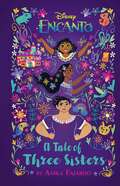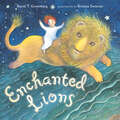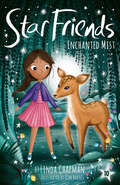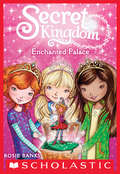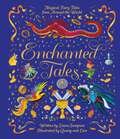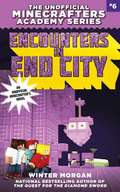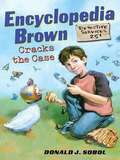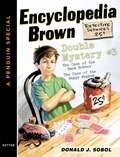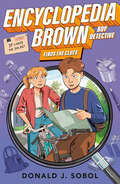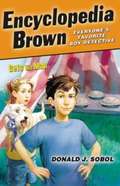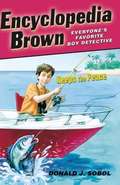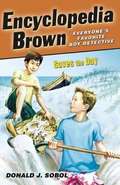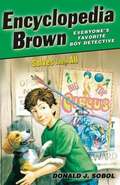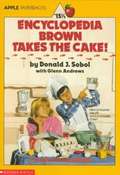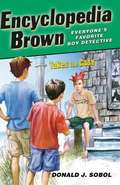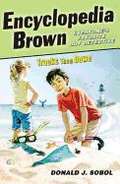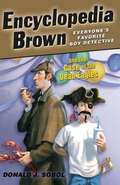- Table View
- List View
EnVision Math -- Common Core (Grade #3)
by Randall I. Charles Mary Cavanagh Janet H. Caldwell Juanita CopleyProblem solving handbook whose features appeal to help students understand. It uses pictures and illustrations; clearly collated with various examples with Plan and Solve following to gauge their understanding. A math textbook designed to get the third graders through to the next level successfully
Encanto: A Tale of Three Sisters
by Disney BooksEncanto tells the tale of an extraordinary family, the Madrigals, who live hidden in the mountains of Colombia, in a magical house, in a vibrant town, in a wondrous, charmed place called an Encanto. <p><p>The magic of the Encanto has blessed every child in the family with a unique gift from super strength to the power to heal―every child except one, Mirabel. But when she discovers that the magic surrounding the Encanto is in danger, Mirabel decides that she, the only ordinary Madrigal, might just be her exceptional family’s last hope.
Enchanted Lions
by David GreenbergOne evening, Rose looks out her window to see enchanted lions climb out of the sea. After she scratches one behind his ears, she climb onto his back for a breathtaking tour of the cosmos. They race with Monoceros the unicorn, jump-rope crescent moons, and are rescued from a black hole by Cetus, the whale. Once back home, they rub noses goodbye and the lions return to the sea, leaving Rose to dream about her interstellar flight. Luminous illustrations perfectly complement melodic text in this out-of-this-world adventure sure to entrance readers as it introduces them to celestial bodies.
Enchanted Mist (Star Friends)
by Linda ChapmanIn this newest installment of the Star Friends series, Mia, Lexi, Violet, and Sita are excited for the activities that their teachers have planned for the end of the school year. But when strange things start happening, the Star Friends know they need to investigate! With black-and-white illustrations throughout.Mia, Lexi, Violet, and Sita are excited about all of the upcoming events to celebrate the end of the school year. Everyone has had a great year except for a new girl named Maddie. She hasn&’t made any friends yet and wishes she were popular. But then suddenly, everyone wants to be her friend. The Star Friends suspect that magic is at play—and could Maddie be behind it all? With black-and-white illustrations throughout.In the Star Friends chapter book series, Mia and her friends Lexi, Sita, and Violet all discover that they are Star Friends -- they can communicate with the animals that have traveled from the Star World. The animals show the girls how to use their unique magic abilities to do good. A whole world of magical adventures awaits!
Enchanted Palace (Secret Kingdom #1)
by Rosie BanksEnter a magical world full of friendship and fun!Ellie, Summer, and Jasmine are the very best of friends. Then one day, they find a magical box that whisks them away to the Secret Kingdom, a world full of every wonderfully magical thing under the sun. But an evil queen wants to ruin the Secret Kingdom so she can rule it for all time. Can the friends help Trixi the pixie save King Merry's 1000th birthday party from Queen Malice's spiky thunderbolt before it's too late?
Enchanted Tales: Magical Fairy Tales from Around the World
by Laura SampsonEmbark on a magical journey with these 18 fantastical fairy tales from around the world, beautifully illustrated by award-winning artists. This stunning collection brings together a diverse selection of enchanted/magical tales from all over the world, including from Siberia, West Africa, North America, Peru, India, Japan, the UK, and Australia. Get lost in tales of imaginary worlds, enchanted animals, fantastical creatures, wizards, and more. A perfect gift and keepsake to open up a world of magic to readers of all ages. Tales include: Under the Iroko Tree (West Africa) Lotus Cloud Mountain (Vietnam) The Star Husbands (North America) The Worn-Out Shoes (France) The Magic Fish (China) Sigurd and Fafnir (Scandinavia) The Stone Cutter (Japan) Tom Tit Tot (England) Oh, the Tsar of the Forest (Ukraine) The Eagles (Poland) The Foolish Brothers (India) The Little Stars of Gold (Czech Republic) Snow White (Germany) The Bird of the Golden Feather (Arabic) Valissa the Beautiful (Russia) Hakuturi (Maori) Bloddeuwed (Wales) The Search for the Magic Lake (Peru/Ecuador)
Encounter
by Brittany Lubyp.p1 {margin: 0.0px 0.0px 0.0px 0.0px; font: 13.0px Times; color: #545454} p.p2 {margin: 0.0px 0.0px 0.0px 0.0px; font: 13.0px Times; color: #545454; min-height: 16.0px} span.s1 {font-kerning: none} A powerful imagining by two Native creators of a first encounter between two very different people that celebrates our ability to acknowledge difference and find common ground. Based on the real journal kept by French explorer Jacques Cartier in 1534, Encounter imagines a first meeting between a French sailor and a Stadaconan fisher. As they navigate their differences, the wise animals around them note their similarities, illuminating common ground. This extraordinary imagining by Brittany Luby, Professor of Indigenous History, is paired with stunning art by Michaela Goade, winner of 2018 American Indian Youth Literature Best Picture Book Award. Encounter is a luminous telling from two Indigenous creators that invites readers to reckon with the past, and to welcome, together, a future that is yet unchartered. p.p1 {margin: 0.0px 0.0px 0.0px 0.0px; font: 13.0px Times} p.p1 {margin: 0.0px 0.0px 0.0px 0.0px; font: 13.0px Times} p.p2 {margin: 0.0px 0.0px 0.0px 0.0px; font: 11.0px Helvetica; min-height: 13.0px} p.p3 {margin: 0.0px 0.0px 12.0px 0.0px; font: 13.0px Times} span.s1 {color: #272c36}
Encounters in End City: The Unofficial Minecrafters Academy Series, Book Six (Unofficial Minecrafters Academy #6)
by Winter MorganIt’s graduation week at Minecrafters Academy, but a battle is brewing between the top five students at the school. With the school’s top five students wrapped up in an endless prank war as they compete over the coveted position of class speaker, one of their classmates finds a solution: the students will travel to an End city and hunt for treasure; the student who not only survives, but returns with the most treasures, will be chosen. The students set off on their journey, but they quickly learn that the End is no joke. Face-to-face with shulkers, the deadly Void, and the mighty Ender Dragon, the school’s top students learn there’s more to success than making the grade. They must learn to fight together—or no one will make it back alive.In this final installment of the Unofficial Minecrafters Academy series, the risks—and the potential rewards—are greater than ever.
Encyclopedia Brown Cracks the Case
by Donald J. SobolLeroy Brown, aka Encyclopedia Brown, is Idaville's ten-year-old star detective. With an uncanny knack for trivia, he solves mysteries for the neighborhood kids. But his dad also happens to be the chief of the police department, and every night Encyclopedia helps him get to the bottom of his most baffling crimes. Join Encyclopedia Brown as he solves ten of his newest and most confounding mysteries, including a case of a missing butterfly brooch, some stolen Confederate stamps, a forgetful jewel thief, and more. With the clues given in each case, readers will have a chance to solve the mystery themselves! Interactive and chock-full of interesting bits of information--it's classic Encyclopedia Brown! "I loved Encyclopedia Brown as a kid."--Junot Diaz, Pulitzer Prize-winning author of The Brief Wondrous Life of Oscar Wao
Encyclopedia Brown Double Mystery (Encyclopedia Brown Series #3)
by Donald J. SobolThis special introductory offer features some of Encyclopedia Brown's first cases ever: "The Case of the Bank Robber" and "The Case of the Happy Nephew." These stories are great for readers new to the series and wonderful nostalgia for those who grew up solving mysteries with the boy detective.
Encyclopedia Brown Finds the Clues (Encyclopedia Brown)
by Donald J. SobolLeroy Brown, aka Encyclopedia Brown, is Idaville neighborhood&’s ten-year-old star detective. With an uncanny knack for trivia, he solves mysteries for the neighborhood kids through his own detective agency. But his dad also happens to be the chief of the Idaville police department, and every night around the dinner table, Encyclopedia helps him solve his most baffling crimes. And with ten confounding mysteries in each book, not only does Encyclopedia have a chance to solve them, but the reader is given all the clues as well. Interactive and chock full of interesting bits of information—it&’s classic Encyclopedia Brown!
Encyclopedia Brown Gets His Man
by Donald J. SobolAbout the Series: Confident readers can match wits with their favorite supersleuth in sneakers in each volume featuring ten short mysteries. Try to crack the cases along with Encyclopedia- the solutions are in the back of the book! About this book: A ghost who whistles. . . Eight stuffed penguins. . . An underwater car. . . A famous explorer's fortune. . . and an ldaville boy who's literally lost his marbles! These are just some of the ten brain- twisting mysteries that Encyclopedia Brown must solve by using his famous computerlike brain. Try to crack the cases along with him- the answers to all the mysteries are found in the back!
Encyclopedia Brown Gets His Man
by Donald J. SobolLeroy Brown, aka Encyclopedia Brown, is Idaville neighborhood's ten-year-old star detective. With an uncanny knack for trivia, he solves mysteries for the neighborhood kids through his own detective agency. But his dad also happens to be the chief of the Idaville police department, and every night around the dinner table, Encyclopedia helps him solve his most baffling crimes. And with ten confounding mysteries in each book, not only does Encyclopedia have a chance to solve them, but the reader is given all the clues as well. Interactive and chock full of interesting bits of information--it's classic Encyclopedia Brown!"I loved Encyclopedia Brown as a kid."--Junot Diaz, Pulitzer Prize-winning author of The Brief Wondrous Life of Oscar Wao
Encyclopedia Brown Gets His Man
by Donald J. SobolLeroy Brown, aka Encyclopedia Brown, is Idaville neighborhood’s ten-year-old star detective. With an uncanny knack for trivia, he solves mysteries for the neighborhood kids through his own detective agency. But his dad also happens to be the chief of the Idaville police department, and every night around the dinner table, Encyclopedia helps him solve his most baffling crimes. And with ten confounding mysteries in each book, not only does Encyclopedia have a chance to solve them, but the reader is given all the clues as well. Interactive and chock full of interesting bits of information—it’s classic Encyclopedia Brown!“I loved Encyclopedia Brown as a kid.”—Junot Diaz, Pulitzer Prize-winning author of The Brief Wondrous Life of Oscar Wao
Encyclopedia Brown Keeps the Peace (Encyclopedia Brown #6)
by Donald J. SobolEncyclopedia Brown has an uncanny knack for trivia. With his unconventional knowledge, he solves mysteries for the neighborhood kids through his own detective agency. But his dad also happens to be the chief of the Idaville police department, and every night around the dinner table, Encyclopedia helps him solve some of the most baffling crimes. With ten confounding mysteries in each book, not only does Encyclopedia have a chance to solve them, but readers are given all the clues as well and can chime in with their own solutions. Interactive and fun--it's classic Encyclopedia Brown!<P><P> Winner of Pacific Northwest Library Association’s Young Reader’s Choice Award
Encyclopedia Brown Lends a Hand
by Donald J. SobolMatch Wits With The World's Greatest Boy Sleuth A huge footprint in the soft earth . . . counterfeit money in a bird's nest . . . a threatening letter . . . an exploding toilet . . . a missing silver dollar . . . and a stolen newspaper clipping that could be valuable! These are the only traces left at the scene of ten brain-twisting crimes that Encyclopedia Brown must solve! #147;I loved Encyclopedia Brown as a kid. ”#151;Junot Diaz, Pulitzer Prize-winning author of The Brief Wondrous Life of Oscar Wao
Encyclopedia Brown Lends a Hand
by Donald J. SobolMatch Wits With The World's Greatest Boy Sleuth A huge footprint in the soft earth . . . counterfeit money in a bird's nest . . . threatening letter . . . an exploding toilet . . . a missing silver dollar . . . and a stolen newspaper clipping that could be valuable! These are the only traces left at the scene of ten brain-twisting crimes. But it's that Encyclopedia Brown, boy super sleuth, needs to solve them.Answers are in the back, but can you solve the mysteries first?
Encyclopedia Brown Saves the Day (Encyclopedia Brown #7)
by Donald J. SobolA camper who's been bound and gagged...A stolen bike wheel...Two kidnapped pigs...A boy with wings...And a foot-warmer inventor who accidentally puts his own foot right in his mouth!These are just some of the ten brain-twisting mysteries that Encyclopedia Brown must solve by using his famous computerlike brain. Try to crack the cases along with him--the answer to all the mysteries are found in the back!
Encyclopedia Brown Shows the Way
by Donald J. SobolA ripped-off rattlesnake...A guard dog that has a nervous breakdown...A pickpocket with a pet kangaroo...And a red-haired red herring!These are just some of the ten brain-twisting mysteries that Encyclopedia Brown must solve by using his famous computerlike brain. Try to crack the cases along with him--the answers to all the mysteries are found in the back!
Encyclopedia Brown Solves Them All
by Donald J. SobolLeroy Brown is back in the next six books in the Encyclopedia Brown series. As Idaville’s ten-year-old star detective, Encyclopedia has an uncanny knack for trivia. With his unconventional knowledge, he solves mysteries for the neighborhood kids through his own detective agency. But his dad also happens to be the chief of the Idaville police department, and every night around the dinner table, Encyclopedia helps him solve some of the most baffling crimes. With ten confounding mysteries in each book, not only does Encyclopedia have a chance to solve them, but readers are given all the clues as well and can chime in with their own solutions. Interactive and fun—it’s classic Encyclopedia Brown!“I loved Encyclopedia Brown as a kid.”—Junot Diaz, Pulitzer Prize-winning author of The Brief Wondrous Life of Oscar Wao
Encyclopedia Brown Takes the Cake!
by Donald J. SobolSolve Encyclopedia's mysteries and then try his favorite recipes. With an updated cover look! Match wits with Encyclopedia Brown and see if you can solve these mysteries before he does, in this exciting compilation featuring Encyclopedia's favorite recipes that you can make at home! - Figure out if Willford's painting of the Liberty Bell is a fake, then celebrate with red, white, and blue shortcake. - Prove that Bugs stole Tim Gomez's pinata, then make a Mexican fiesta. - Solve the Case of the Secret Recipe, then serve up some Idaville Apple Pie.
Encyclopedia Brown Takes the Case
by Donald J. SobolAs Idaville’s ten-year-old star detective, Encyclopedia has an uncanny knack for trivia. With his unconventional knowledge, he solves mysteries for the neighborhood kids through his own detective agency. But his dad also happens to be the chief of the Idaville police department, and every night around the dinner table, Encyclopedia helps him solve some of the most baffling crimes. With ten confounding mysteries in each book, not only does Encyclopedia have a chance to solve them, but readers are given all the clues as well and can chime in with their own solutions. Interactive and fun—it’s classic Encyclopedia Brown!“I loved Encyclopedia Brown as a kid.”—Junot Diaz, Pulitzer Prize-winning author of The Brief Wondrous Life of Oscar Wao
Encyclopedia Brown Tracks Them Down
by Donald J. SobolLeroy Brown is back in the next six books in the Encyclopedia Brown series. As Idaville's ten-year-old star detective, Encyclopedia has an uncanny knack for trivia. With his unconventional knowledge, he solves mysteries for the neighborhood kids through his own detective agency. But his dad also happens to be the chief of the Idaville police department, and every night around the dinner table, Encyclopedia helps him solve some of the most baffling crimes. With ten confounding mysteries in each book, not only does Encyclopedia have a chance to solve them, but readers are given all the clues as well and can chime in with their own solutions. Interactive and fun-it's classic Encyclopedia Brown!
Encyclopedia Brown Tracks Them Down
by Donald J. SobolA tiny submarine that flies through the air...A half-dollar worth five thousand dollars...Some tipsy birds...A world that fits in the palm of your hand...And a case that turns out to be a real can of worms!These are just some of the ten brain-twisting mysteries that Encyclopedia Brown must solve by using his famous computerlike brain. Try to crack the cases along with him--the answers to all the mysteries are found in the back!
Encyclopedia Brown and Dead Eagles
by Donald J. SobolSolve some more puzzling mysteries with super sleuth Encyclopedia Brown! Leroy Brown is back in the Encyclopedia Brown series. As Idaville's ten-year-old star detective, Encyclopedia has an uncanny knack for trivia. With his unconventional knowledge, he solves mysteries for the neighborhood kids through his own detective agency. But his dad also happens to be the chief of the Idaville police department, and every night around the dinner table, Encyclopedia helps him solve some of the most baffling crimes. With ten confounding mysteries, not only does Encyclopedia have a chance to solve them, but readers are given all the clues as well and can chime in with their own solutions. Interactive and fun, it's classic Encyclopedia Brown! #147;I loved Encyclopedia Brown as a kid. ”#151;Junot Diaz, Pulitzer Prize-winning author of The Brief Wondrous Life of Oscar Wao

